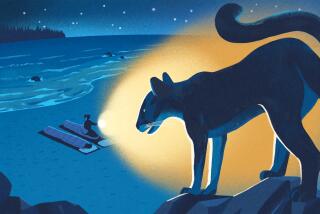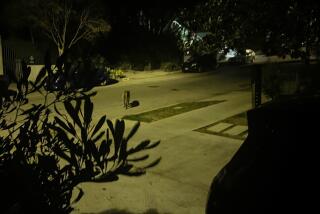A Chronicle of Warfare in the Night : Television: Dereck and Beverly Joubert document the struggle between lions and hyenas in tonight’s “National Geographic” and dispel some myths along the way.
- Share via
In the dark of the African night, the hyenas’ eyes glow brightly in the photographer’s lights, making the feral creatures look like demons from hell as they circle the lion and its kill. The King of Beasts growls angrily and makes short feints toward his harassers, but they care little for his royalty. Ultimately he cannot withstand the ferocity of their attack and spends the rest of the night up a tree.
Life on the African veldt is hard and, often, short. But that truism fails to describe the ongoing conflict between lions and hyenas that is documented by wildlife photographers Dereck and Beverly Joubert in “Eternal Enemies: Lions and Hyenas,” tonight’s “National Geographic” special on PBS (at 7 on KVCR Channel 24, at 8 on KCET Channel 28 and KPBS Channel 15).
The Jouberts’ unprecedented images of animal warfare in the African night portray a combat that is not just a fierce struggle for control of a limited food supply or a simple fight for survival. Instead, they show a fierce blood feud in which savage hunters compete for the sheer thrill of combat, for the joy of victory over a mortal enemy. If animals could hate, says Dereck Joubert, this is what it would look like.
The Jouberts have shed a new light--both literally and metaphorically--on the behavior of hyenas. By studying them during the dark of the night, a period that has been neglected by previous researchers even though it is when the hyenas are most active, the Jouberts have provided valuable new insights into the behavior of one of the most aggressive animals in the wild, insights that debunk some of the myths about hyenas and lions.
The hyenas, contrary to the common view, are not just scavengers. They are competent hunters that can easily hunt down much larger prey. In large numbers, they can even overcome lions to win the spoils of a kill. And the lions themselves are not just proud hunters. They too will become scavengers if the opportunity presents itself.
The Jouberts are South African, he a geologist by training, she a business major. They have spent more than 15 years on the Southern African veldt, starting out as game rangers before graduating to filming documentaries. They have been observing lions and hyenas in the Savuti region of Chobre National Park in northern Botswana for 10 years.
Their “National Geographic” special is the end product of two years of intensive work in which they spent 320 days per year living and working out of a specially modified four-wheel-drive truck that allowed them to follow the animals in their journeys across the park. Their base camp was hardly more luxurious: two tents, one for living and one for editing the miles of film that Dereck Joubert shot.
One key to shooting at night was the special lights he used. After trying many different types of lights, Joubert ultimately settled on Boeing aircraft landing lights, which provided the illumination he needed without being overpowering. They are powered by nickel-cadmium batteries that allow about an hour’s shooting each night. The batteries are then recharged during the daytime with a small generator.
Patience is also a must. Working with a new group of animals, the Jouberts would often spend two weeks or longer simply allowing them to get used to the lights and their vehicle. “Night after night we sat with them, gradually moving in closer and closer and putting soft lights on them for longer and longer,” said Beverly Joubert. After the first two weeks, “We could work with them without any fear of interference or affected behavior.”
And photographing at night was crucial, Dereck Joubert said. Previous researchers who studied hyenas at night worked during periods of moonlight when little of importance was happening. Only after the moon set did most nocturnal activities begin. “We found we could set our alarm clocks and sleep until the moon went down without missing anything,” he said.
What they witnessed after moonset was unprecedented violence. Hyenas--which look like dogs but are actually members of the cat family--are among the most aggressive animals in the wild, possibly because they are exposed to high levels of the male hormone androgen in the womb.
Because of the hormone exposure, hyenas are, quite literally, born fighting, according to biologist Laurence G. Frank of UC Berkeley. Hyena females typically have twins and, if they are of the same sex, the first-born invariably tries to kill the second in the first hours of life. Frank and his colleagues reported last summer that they had observed this behavior for the first time in a captive breeding colony of the animals in Berkeley. The Jouberts have now documented it among wild animals as well.
That attitude was also visible in an unprecedented display of aggression captured by the Jouberts. Most animals mark the boundaries of their territories with scents--either urine or pheromones from special glands. These markers serve to warn away other members of the same species, and are ignored by other species.
Joubert filmed the matriarch of the hyena clan deliberately tormenting a young male lion. As the lion marked off the edges of its territory, the hyena confidently followed along behind, throwing dirt on the lion’s markings and depositing her own.
This behavior continued until a second male lion, who had previously killed many hyenas, was drawn to the scene by the commotion. This male immediately chased down the matriarch and killed her with a powerful bite to the neck. Because no food was involved in the episode, it clearly suggests the deep enmity between the two species.
The Jouberts are unsparing in showing the violence of the veldt. One of the most affecting segments of the show involves a young lioness that they named Motsumi. They followed Motsumi into the nearby hills where, safe from the hyenas, she gave birth to three cubs.
Lionesses move their cubs to a new location frequently because the old one becomes filled with the scent of vulnerable new life. But one of her moves was ill-timed. She deposited the cubs under some shady bushes that were, unfortunately, also occupied by an Egyptian cobra. The cobra attacked all four, killing the cubs instantly and disabling the mother.
The Jouberts followed Motsumi for seven days, convinced each night that she would not live to see the sun rise. On the fourth day, she even fought off an attack by several hyenas. To their surprise, she survived and rejoined her pride.
Why didn’t they help her or the cubs?
“It’s ludicrous to think we should influence something that’s been going on for 10 million years,” Dereck said. “Just because it happened in front of us doesn’t mean we should interfere. If we stepped in any time our emotions were touched, we wouldn’t get anything near a documentary.”
More to Read
The biggest entertainment stories
Get our big stories about Hollywood, film, television, music, arts, culture and more right in your inbox as soon as they publish.
You may occasionally receive promotional content from the Los Angeles Times.










